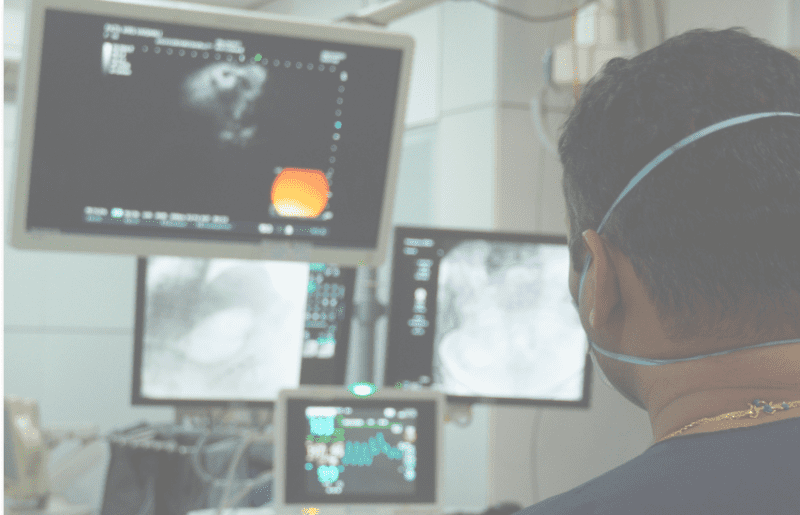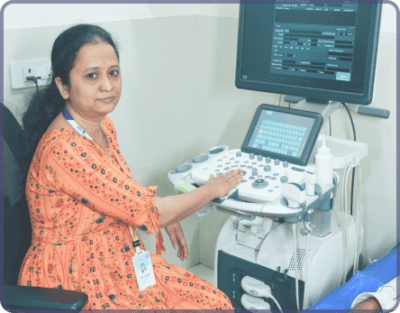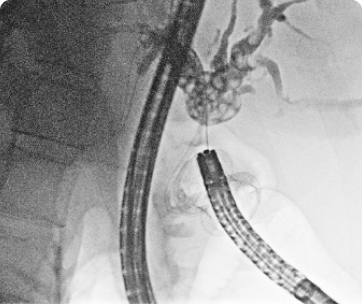SPIRUS ENTEROSCOPY
Endoscopy is looking inside body through an optical instrument. There are many types of endoscopies named after organs that are visualized.

UPPER GI ENDOSCOPY

Endoscopy is looking inside body through an optical instrument. There are many types of endoscopies named after organs that are visualized.
Spirus enteroscopy is a medical procedure used to examine the small intestine, which is not easily accessible through conventional endoscopy procedures. It uses a flexible, long endoscope with a camera at its tip to capture images of the small intestine.
1,11,1000+ CASES HANDLED
3 HI-TECH ENDOSCOPY DEVICES
5+ SPECIALIST GI ENDOSCOPIST
Before the procedure, the patient is sedated and given pain medication.
The endoscope is inserted into the mouth or anus and advanced through the digestive tract.
As the endoscope advances, the camera captures images of the small intestine, which are displayed on a monitor for the physician to examine.
If necessary, the physician can also perform therapeutic interventions, such as taking biopsies, removing polyps, or stopping bleeding.
The procedure typically takes between 60 and 90 minutes, and the patient can go home the same day.
The procedure is indicated for the evaluation of unexplained gastrointestinal bleeding, diagnosis of malabsorption syndromes, evaluation of unexplained abdominal pain, detection and removal of small intestinal polyps, diagnosis of Crohn’s disease and other inflammatory bowel diseases, evaluation of suspected small bowel tumors, diagnosis of celiac disease, and assessment of postoperative complications in patients who have had minor bowel surgery.
Patients should fast for at least 8 hours before the procedure, perform bowel preparation, adjust or stop taking certain medications, undergo a health assessment, and receive anesthesia.
The procedure is generally considered safe, but there is a risk of bleeding, perforation, infection, adverse reaction to sedation, pancreatitis, and fecal impaction.
Before the procedure, the patient is sedated and given pain medication.
The endoscope is inserted into the mouth or anus and advanced through the digestive tract.
As the endoscope advances, the camera captures images of the small intestine, which are displayed on a monitor for the physician to examine.
If necessary, the physician can also perform therapeutic interventions, such as taking biopsies, removing polyps, or stopping bleeding.
The procedure typically takes between 60 and 90 minutes, and the patient can go home the same day.
The procedure is indicated for the evaluation of unexplained gastrointestinal bleeding, diagnosis of malabsorption syndromes, evaluation of unexplained abdominal pain, detection and removal of small intestinal polyps, diagnosis of Crohn’s disease and other inflammatory bowel diseases, evaluation of suspected small bowel tumors, diagnosis of celiac disease, and assessment of postoperative complications in patients who have had minor bowel surgery.
Patients should fast for at least 8 hours before the procedure, perform bowel preparation, adjust or stop taking certain medications, undergo a health assessment, and receive anesthesia.
The procedure is generally considered safe, but there is a risk of bleeding, perforation, infection, adverse reaction to sedation, pancreatitis, and fecal impaction.

PROCEDURES WE CONDUCT
FREQUENTLY ASKED QUESTIONS
FREQUENTLY ASKED QUESTIONS
Don’t wait!!
Get consulted with our GI specialist today
Book your appointment effortlessly.
ANTRANG KNOWLEDGE RESOURCE
ANTRANG KNOWLEDGE RESOURCE
get in touch
We are just a phone call away when you need us!








